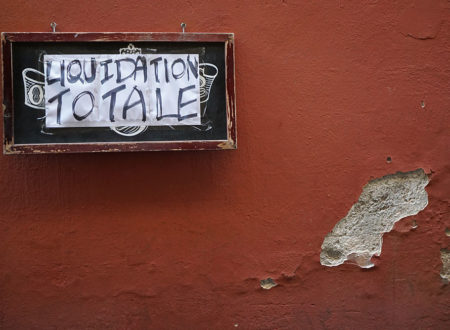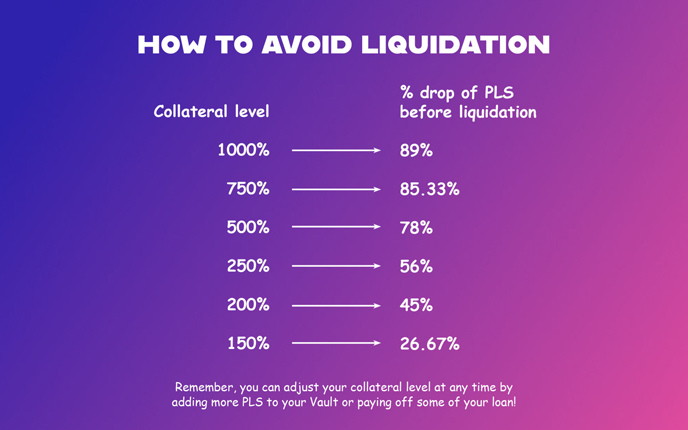How To Avoid PLS Liquidations

To the uninitiated, the term ‘liquidation’ can sound pretty scary – “Oh no, I’m going to lose all my PLS!” – but to those who really understand the Liquid Loans protocol, PLS liquidations can be a good thing. Like so many things in life, it all depends what you’re trying to achieve.
The TLDR is, if you want to make sure your Vault never gets liquidated, make sure to stay over 150% collateralized at all times. That way, even if the system enters Recovery Mode, your Vault will not be liquidated.
Staying safely collateralized is very easy, and you don’t have to watch your Vault like a hawk all day long. Simply download a crypto price alert app onto your phone and set alerts for PLS. If PLS drops by the percentage you set in the app, you’ll be notified, and you can adjust your collateral levels accordingly.
We strongly recommend inexperienced users of our protocol to set a high collateralization level – say 1000% – until they are comfortable they fully understand the system.
With this said and done, let’s get into the nuts and bolts of how liquidations actually work inside the Liquid Loans protocol.
Liquidations are not automatic (but…bots will likely be made)
When a Vault slips under 110% collateralization (or 150% in the rare case of Recovery Mode), that Vault becomes eligible for liquidation. This helps maintain the health of the protocol by ensuring that the entire USDL supply remains fully backed by collateral (PLS).
Anyone can run the liquidation function – you don’t have to be a Liquid Loans user or have an active Vault or anything like that. However, if you’re planning on doing it, you would want to have very quick fingers.
Why? Because it’s likely that people will create bots to run this function in order to get the (very generous) gas compensation (200 USDL + 0.5% of the Vault’s collateral) as reward.
What happens to the PLS from Liquidated Vaults?
When a Vault is liquidated, the PLS that was in that Vault is distributed among the Stability Providers in proportion to their size in the Stability Pool.
The borrower’s debt is cancelled, their Vault disappears, and they keep the USDL they minted. In other words, their loan is paid off and closed.
What happens if the Stability Pool is empty when the liquidation occurs?
Put simply, this will almost certainly never happen. However, if it were to happen (for whatever reason) the system uses a secondary liquidation mechanism called redistributions, where the system redistributes the debt and collateral from liquidated Vaults to all other existing Vaults.
The redistribution of debt and collateral is done in proportion to the recipient Vault’s collateral amount.

How do I benefit as a Stability Provider from liquidations?
As liquidations happen just below a collateral ratio of 110%, if you’re providing stability, then you will most likely experience a net gain whenever a Vault is liquidated.
Here’s an example:
Let’s say there is a total of 1,000,000 USDL in the Stability Pool and your deposit is 100,000 USDL.
If a Vault with a debt of 200,000 USDL and collateral of 400,000,000 PLS is liquidated at a PLS price of $0.000545, and thus at a collateral ratio of 109% (= 100% * (400,000,000 * .000545) / 200,000), given that your pool share is 10%, your deposit will go down by 10% of the liquidated debt (20,000 USDL), i.e. from 100,000 to 80,000 USDL.
In return, you will gain 10% of the liquidated collateral, i.e. 40,000,000 PLS, which is currently worth $21,800. Your net gain from the liquidation is $1,800.
You could then, if you wanted to, immediately withdraw the PLS collateral you received from the liquidation, or you could place it in your Vault. It’s up to you.
How can liquidations be a good thing?
Liquidations can serve as a stop loss, and experienced users may be able to end up in a better position due to a liquidation occurring.
Obviously, you will take an instant loss due of up to 10% due to the liquidation, but if the price continues to fall further than that you could benefit.
Here's an example:
- Let's say you take a 50,000 USDL loan using 100,000 USD worth of PLS (at price of $1) as collateral.
- If the price of PLS falls by 45% to $0.55 your vault could be liquidated.
- Initially you would end up with a quick 10% loss.
- However, if the price of PLS continues to drop, let's say to $0.30 you now have 50,000 USDL.
- If you hadn't taken the loan, you would've had 30,000 USD worth of PLS
- Now you can buy back the PLS with your USDL, if you wish, and you'd end up with 166,666 PLS which is more than you originally had.
How can you Avoid PLS Liquidations?
As mentioned above, the simple answer to this question is to stay over 150% collateralized at all times. Here’s a graphic made by one of our community members that can give you some more context.

Join The Leading Crypto Channel
JOINDisclaimer:Please note that nothing on this website constitutes financial advice. Whilst every effort has been made to ensure that the information provided on this website is accurate, individuals must not rely on this information to make a financial or investment decision. Before making any decision, we strongly recommend you consult a qualified professional who should take into account your specific investment objectives, financial situation and individual needs.

Connor
Connor is a US-based digital marketer and writer. He has a diverse military and academic background, but developed a passion over the years for blockchain and DeFi because of their potential to provide censorship resistance and financial freedom. Connor is dedicated to educating and inspiring others in the space, and is an active member and investor in the Ethereum, Hex, and PulseChain communities.

Development
Knowledge
Subscribe To Newsletter
Stay up-to-date with all the latest news about
Liquid Loans, Fetch Oracle and more.
Copyright © 2024 Crave Management.
All Rights Reserved.

The LL Librarian
Your Genius Liquid Loans Knowledge Assistant




